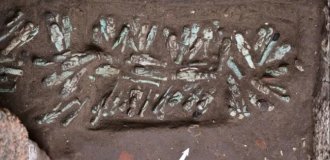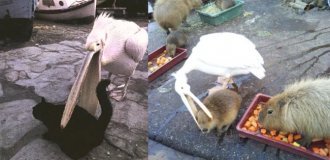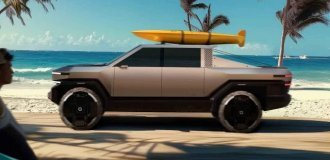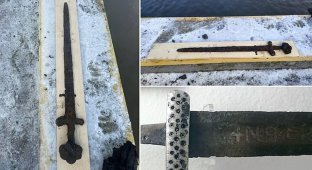Workhorses of the Viking Age. How knorrs were created and used (4 photos)
Anyone interested in the history of the fleet sooner or later learned about the Scandinavian sailors. Information about their valor, courage, military and naval art has reached the present day through oral sagas, which the "longhouse public" loved to listen to. 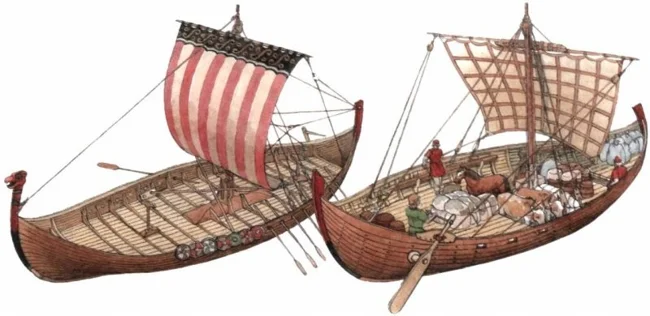
Drakkar and knorr in comparison
Historical research, however, has shown that this valor, courage and military art were quite unique, and the word "Viking" means a profession rather than a people. But there is no doubt about the seafaring skills of the Scandinavians.
When it comes to Viking ships, the first thing that comes to mind is the long, fast drakkars. But the real "workhorses" of that era were not them, but the knorrs (Old Norse knǫrr) - leisurely and roomy ships. It was on them that the Scandinavians carried out transportation and even sailed to America. The knorr proved indispensable for the campaigns, wars, explorations and trade of that time.
The word knǫrr itself is often found in runic inscriptions, sagas and medieval laws. In "Egil's Saga" "knǫrr mikill" ("big knorr") is mentioned. And in "The Saga of the Greenlanders" the knorr is described as a vessel capable of transporting cattle, goods and settlers.
If drakkars were combat ships, fast, maneuverable and intimidating with a low draft, then knorrs were more like solid vans, wide and stable. The knorr did not shine with elegance. Its barrel-shaped hull was created for transporting cargo, not for speed. The dimensions of the largest of the knorrs found reached 16.5 meters in length and 4.6 meters in width. Sides up to 1.2 m high protected the cargo from lashing waves. Oak was used as a material for the hull whenever possible. This guaranteed both strength and relative stability in a storm.
The design with 4-6 pairs of oars and a large sail allowed the knorr to maintain a decent speed even in unfavorable winds, making it an ideal choice for long voyages.
A completely different approach was embodied in the drakkars, which were designed exclusively for military purposes. These ships with a minimal draft (only 0.5-1 meter) were created for lightning raids and attacks in coastal waters. Their design with numerous oars (up to 78 pieces) and an auxiliary sail provided unprecedented maneuverability and independence from the wind, allowing the Vikings to make rapid raids and escape pursuit in shallow waters inaccessible to other ships.
These technical differences clearly demonstrate how Scandinavian shipbuilders invented specialized ships for specific tasks.
The Knorr, being the main trading vessel of the Vikings, carried a variety of cargo that ensured the life of the colonists. Among the food products, especially important were barrels of salted and dried fish, dried and salted meat, as well as grain and honey. No less important were raw materials and industrial goods in the form of metals, wood, furs and walrus ivory, which served as important export goods.
At the same time, despite the significant carrying capacity, the knorr did not require a large crew. Only 5-8 people were enough to successfully operate the vessel. To protect the ship and cargo, 4-5 warriors could be taken on board, so on average there were about 11 people on the knorr.
Knorrs were also actively used to transport passengers. In addition to the crew, they could take on board up to 30 people during coastal voyages. Such a capacity allowed knorrs to remain cost-effective means of transport, while simultaneously ensuring the safety and comfort of passengers and crew during long sea voyages.
History has preserved various examples demonstrating the key role of knorrs in the Viking Age. The first large-scale test for these ships was the colonization of Iceland. As the "Book of the Taking of the Land" testifies, it was on knorrs that the first settlers transported across the northern waters not only their families, but also livestock, building materials, household utensils and everything else necessary for settling in a new place. 
Modern reconstruction of a knorr
A real triumph of the knorrs was the Greenlandic epic of Eric the Red, described in the eponymous saga. Eric, a Norwegian by birth, exiled first from Norway and then from Iceland, decided to go in search of the mysterious land that the navigator Gunnbjørn Ulfsson spoke of. To do this, Eric assembled a whole flotilla of 30 ships and recruited a large team of colonists.
Only 14 ships and about 350 people on them reached their destination, while the rest either perished in storms or turned back. The survivors founded the first European settlements on Greenland called Eystribyggd (Eastern) and Vestribyggd (Western). The evidence of the sagas is confirmed by the results of radiocarbon analysis of archaeological finds that were discovered on the site of the former Brattalid (now Qassiarsuk). The travelers who became settlers managed to establish life in harsh conditions, farming, hunting sea animals and trading with Europe, where walrus ivory and skins were highly valued. Without capacious knorrs, such colonization would not have been possible.
Of particular interest is the expedition of Leif Eriksson (son of Eric the Red) to the shores of North America around the year 1000. Two ancient sagas describe this event. The Saga of the Greenlanders tells of Eriksson's discoveries of Helluland, Markland, and Vinland, the locations of which he was told by a certain Bjarni Herjulfsson. The Saga of Erik the Red emphasizes the purposeful exploration of new territories and the Christian mission of Leif, nicknamed the Fortunate.
For such a risky undertaking, Leif chose the time-tested knorr, like his father, who had reached Greenland. This vessel became the ideal means of transatlantic passage. It was the reliability and capacity of the knorrs that allowed the Vikings to be several centuries ahead of Columbus in discovering the New World. 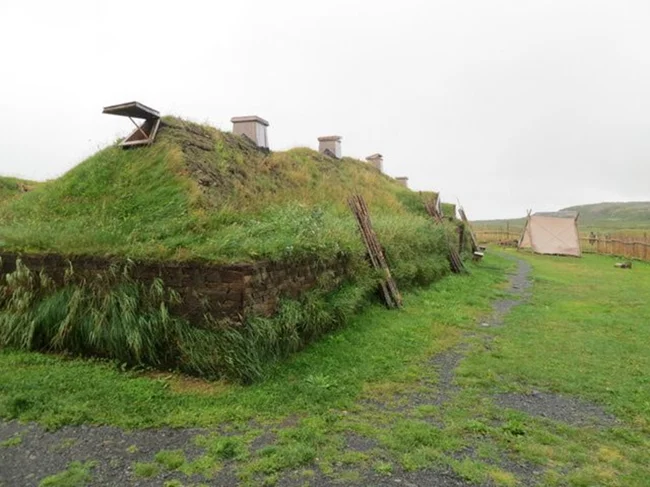
Reconstruction of the first settlements on the shores of "Vinland"
Despite its apparent simplicity, the creation of the knorr required considerable effort. Construction began with a careful selection of materials. The craftsmen looked for a perfectly straight oak trunk for the keel. This trunk was hewn with an axe, giving it the desired shape, and special grooves were made for the future attachment of the frames. When the keel was ready, they began assembling the frame. The frames were installed and fixed with wooden wedges, forming "ribs". The bow and stern were created simultaneously, giving the vessel its characteristic streamlined shape.
The next stage was the hull planking. The boards were laid from the bottom up, using the traditional clinker technique - each new board slightly overlapped the previous one. They were fastened with iron rivets, which were forged directly at the shipyard. To seal the seams, wool soaked in pine resin was laid, and the entire hull was covered with a mixture of tar and animal fat, creating a water-repellent layer.
Special attention was paid to the sail rigging. The mast was attached to a powerful internal reinforcement - a keelson, which distributed the load across the entire hull. The sail was sewn from thick woolen fabric, which was also impregnated with fat to protect against moisture. Its area could reach 90 square meters.
The construction was completed with equipment. The anchor was a stone with wooden hooks, and 4-6 pairs of oars were provided for movement in calm weather. In the cargo compartment, arranged on top of the stone ballast, a plank flooring was placed. The entire process of building one knorr took about 3-4 months and required the participation of experienced craftsmen.
The knorr did not become a widely known symbol of the conquests and campaigns of the Vikings. But it was thanks to it that the harsh inhabitants of the north reached the shores of distant lands and brought a piece of their culture to the spaces from Ancient Rus' to Sicily. Modern reconstructions have proven that for its time the knorr was a technically perfect vessel. It did not just transport goods. In fact, entire civilizations traveled on it. It was with its help that the Vikings successfully developed new lands. 
The material was prepared by the volunteer editorial staff of "World of Ships"
